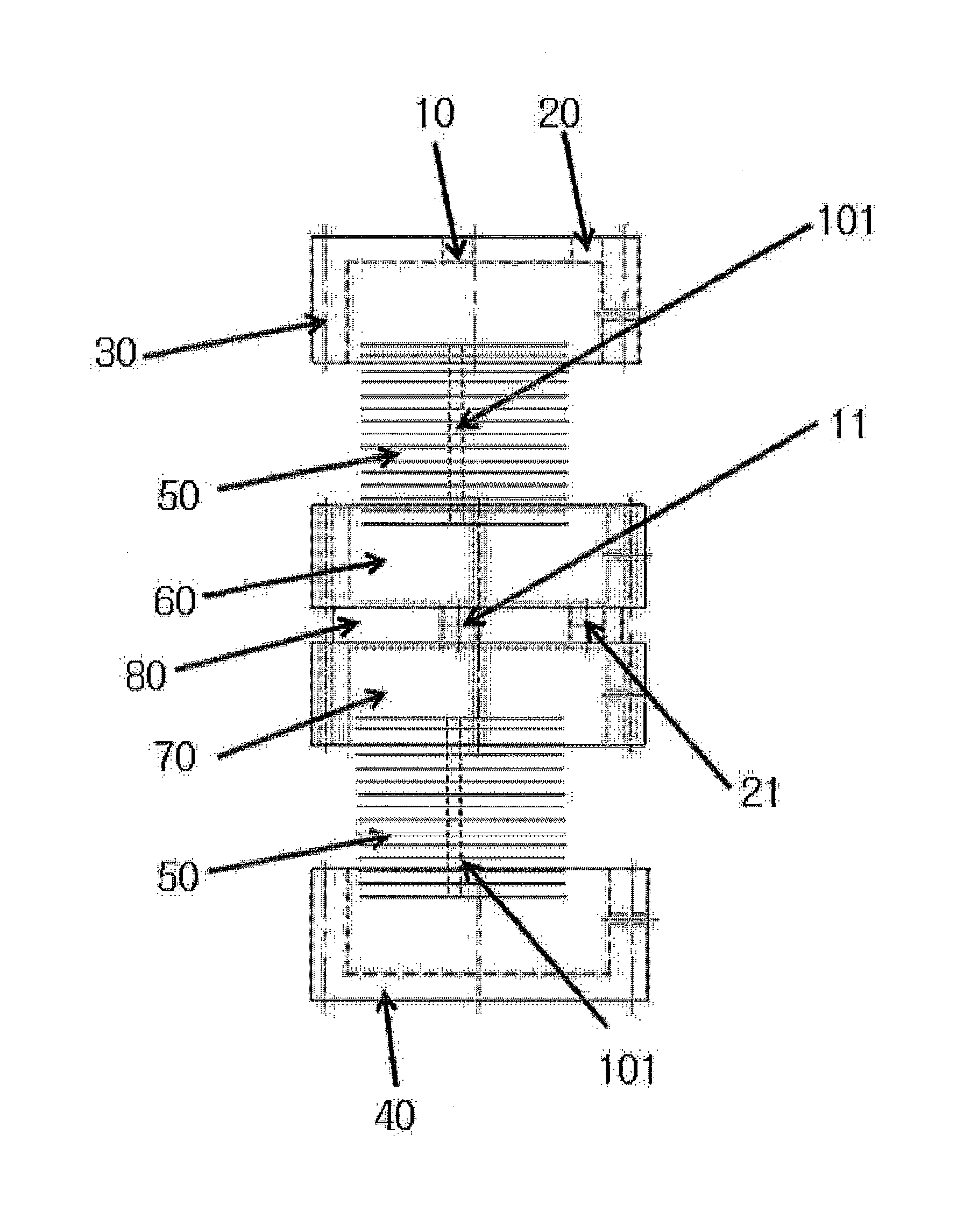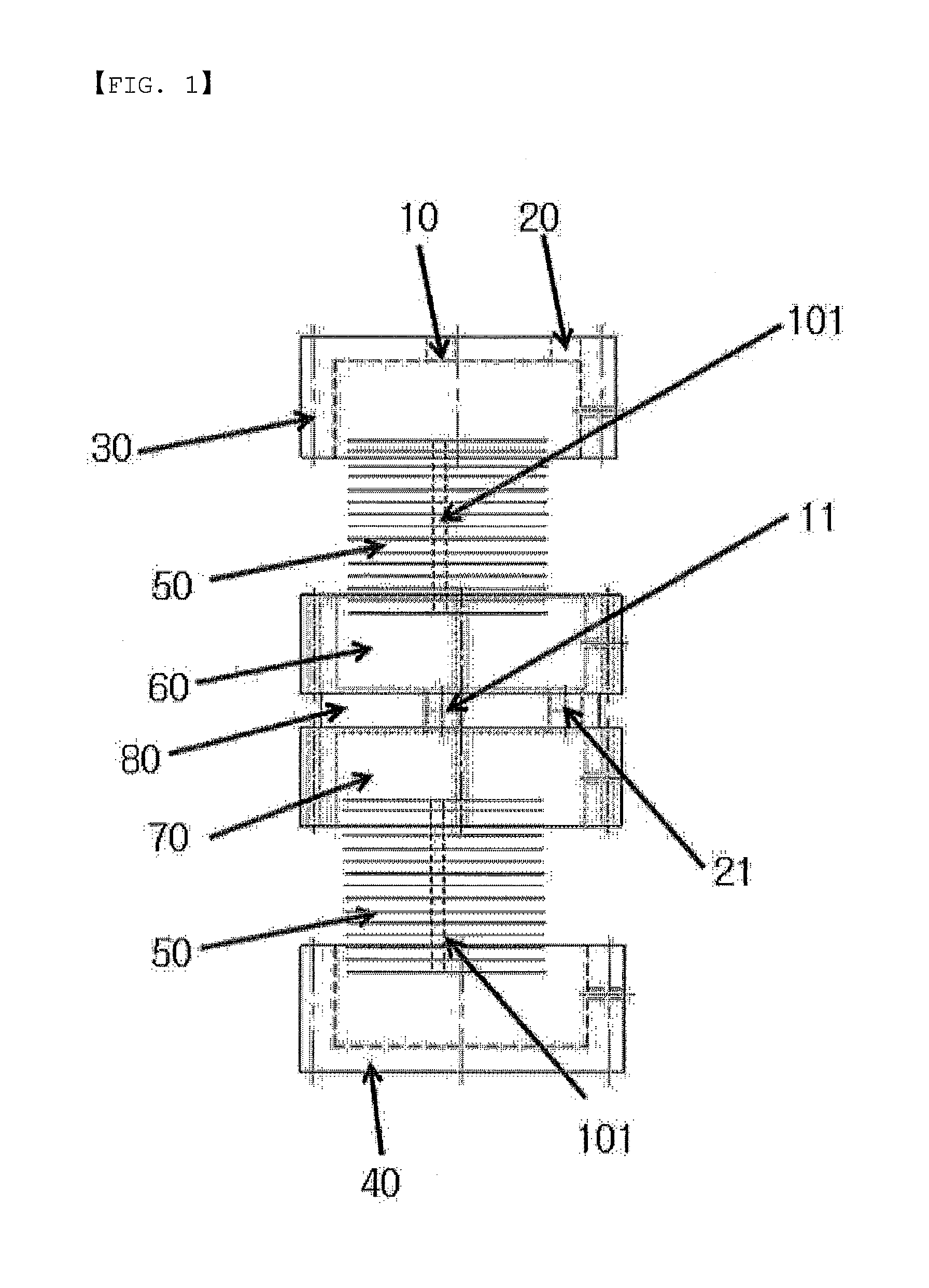Ion-Selective Capacitive Deionization Composite Electrode, and Method for Manufacturing a Module
a capacitive deionization and composite electrode technology, applied in the field of cdi composite electrodes, can solve the problems of affecting the health of people, affecting the adsorption and desorption rate of ions, affecting the filtration efficiency of the process, etc., and achieves the effect of increasing the adsorption efficiency, increasing the adsorption rate, and preventing fouling from being accumulated
- Summary
- Abstract
- Description
- Claims
- Application Information
AI Technical Summary
Benefits of technology
Problems solved by technology
Method used
Image
Examples
manufacturing example 1
Manufacturing of Electrode Having Cation Selectivity
[0067]A polymer solution was manufactured by mixing 1.0 g of polystyrene (cation-exchange capacity=1.5 meq / g, MW=350,000) having a cation-exchange group prepared by sulfonation reaction with 40 g of dimethylacetamide (DMAc) and a cation-exchange electrode slurry was prepared by mixing 9.0 g of an activated carbon powder (P-60, Daedong AC (Co.), specific surface area=1600 m2 / g) with the polymer solution.
[0068]A negative electrode having cation selectivity was manufactured by coating the prepared slurry on both sides of a conductive graphite sheet (a thickness of 130 μm, Dongbang Carbon (Co.), Cat. No. F02511C), respectively, by doctor blade, wherein a thickness of the coating layer on one surface thereof is 200 μm, and then, drying the coated slurry at 70° C. for 30 minutes.
manufacturing example 2
Manufacturing of Electrode Having Anion Selectivity
[0069]A polymer solution was manufactured by mixing 1.0 g of polyethersulfone (anion-exchange capacity=1.2 meq / g, MW=350,000) having an anion-exchange group prepared by aminiation reaction with 40 g of dimethylacetamide (DMAc) and an anion-exchange electrode slurry was prepared by mixing 9.0 g of an activated carbon powder (P-60, Daedong AC (Co.), specific surface area=1600 m2 / g) with the polymer solution.
[0070]A positive electrode having anion selectivity was manufactured by coating the prepared slurry on both sides of a conductive graphite sheet (a thickness of 130 μm, Dongbang Carbon (Co.), Cat. No. F02511C), respectively, by doctor blade, wherein a thickness of the coating layer on one surface thereof is 200 μm, and then, drying the coated slurry at 70° C. for 30 minutes.
manufacturing example 3
Manufacturing of Electrode Using Polyvinylidenedifluoride Slurry
[0071]The polymer solution was prepared by mixing 0.4 g of polyvinyledenedifluoride (PVdF, Aldrich, Mw=1,800,000) with 40 g of dimethylacetamide and the electrode slurry was prepared by mixing 9.6 g of the activated carbon powder (P-60, Daedong AC (Co.), specific surface area=1600 m2 / g) with the polymer solution.
[0072]A non-ionic electrode no having anion and cation selectivity was manufactured by coating the prepared slurry on both sides of a conductive graphite sheet (a thickness of 130 μm, Dongbang Carbon (Co.), Cat. No. F02511C), respectively, by doctor blade, wherein a thickness of the coating layer on one surface thereof is 200 μm, and then, drying the coated slurry at 70° C. for 30 minutes.
PUM
| Property | Measurement | Unit |
|---|---|---|
| electrode potential | aaaaa | aaaaa |
| particle size | aaaaa | aaaaa |
| particle size | aaaaa | aaaaa |
Abstract
Description
Claims
Application Information
 Login to View More
Login to View More - R&D
- Intellectual Property
- Life Sciences
- Materials
- Tech Scout
- Unparalleled Data Quality
- Higher Quality Content
- 60% Fewer Hallucinations
Browse by: Latest US Patents, China's latest patents, Technical Efficacy Thesaurus, Application Domain, Technology Topic, Popular Technical Reports.
© 2025 PatSnap. All rights reserved.Legal|Privacy policy|Modern Slavery Act Transparency Statement|Sitemap|About US| Contact US: help@patsnap.com



